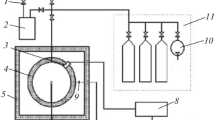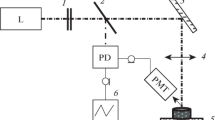Abstract
The combustion kinetics of H2-air mixtures containing small amounts (<1%) of ozone is analyzed for the case of excitation of asymmetric vibrations of O3 molecules by CO2 laser radiation with a wavelength of ≈ 9.7 µm. It is shown that the irradiation leads to acceleration of the collisional dissociation of O3 molecules, activation of the chain ignition mechanism, and a decrease in the induction period and ignition temperature. The excitation of asymmetric vibrations of O3 molecules by the CO2 laser radiation is 10–103 times more effective than the currently used method of combustion initiation based on local heating of a medium by IR radiation.
Similar content being viewed by others
REFERENCES
Ya. B. Zel’dovich, G. I. Barenblatt, V. B. Librovich, and G. M. Makhviladze, Mathematical Theory of Combustion and Detonation [in Russian], Nauka, Moscow (1980).
G. C. Light, “The effect of vibrational excitation on the reaction of O(3P) with H2 and the distribution of vibrational energy in the product OH,” J. Chem. Phys., 68, No.6, 2831–2843 (1978).
M. Capitelli (ed.), Nonequilibrium Vibrational Kinetics, Springer-Verlag, Berlin (1986).
R. C. Brown, “A theoretical study of vibrationally induced reactions in combustion processes,” Combust. Flame, 62, No.1, 1–12 (1985).
A. M. Starik and N. G. Dautov, “On the possibility of accelerating the combustion of H2 + O2 mixtures by excitation of the vibrational degrees of freedom of the molecules,” Dokl. Ross. Akad. Nauk, 336, No.5, 617–622 (1994).
A. M. Starik and N. S. Titova, “On the kinetic mechanisms of combustion initiation for hydrogen-air mixtures in supersonic postshock flow with excitation of molecular vibrations of the starting reactants,” Zh. Tekh. Phys., 71, No.8, 1–12 (2001).
N. G. Basov, V. A. Danilychev, V. A. Dolgikh, et al., “Limiting specific energy contribution to hydrogen and the role of VV processes,” Kvant. Elektron., 13, No.6, 1161–1168 (1986).
V. V. Lunin, M. P. Popovich, and S. N. Tkachenko, Physical Chemistry of Ozone [in Russian], Izd. Mosk. Univ., Moscow (1998).
W. M. Trott, “CO2-laser induced deflagration of fuel/oxygen mixtures,” J. Appl. Phys., 54, No.1, 118–130 (1983).
B. Raffel, J. Warnatz, and J. Warnatz, “Experimental study of laser-induced thermal ignition in O2/O3 mixtures,” J. Appl. Phys. B, 37, No.4, 189–195 (1985).
M. A. Tanoff, M. D. Smooke, R. E. Teets, and J. A. Sell, “Computational and experimental studies of laser-induced thermal ignition in premixed ethylene-oxidizer mixtures,” Combust. Flame, 103, No.4, 253–280 (1995).
V. Ya. Panchenko, I. M. Sizova, and A. P. Sukhorukov, “Dynamics of gas-temperature establishment in vibrationally excited ozone,” Appl. Mech. Tech. Phys., No. 4, 452–460 (1981).
J. S. Margolis, “N2 broadening parameters of ozone at 9.6 µm,” J. Quant. Spectrosc. Radiat. Transfer, 29, No.6, 539–542 (1983).
V. I. Grabovskii and A. M. Starik, “Variation in the refraction index during interaction of a radiation pulse with an inverse medium,” Kvant. Elektron., 21, No.4, 365–370 (1994).
A. M. Starik and N. S. Titova, “Decreasing the ignition temperature of molecular systems by nonequilibrium excitation of the vibrational degrees of freedom of the reacting molecules,” Kinet. Katal., 41, No.5, 650–657 (2000).
N. G. Dautov and A. M. Starik, “Effect of excitation of molecular vibrations on the dynamics of combustion of an H2 + O2 mixture behind a detonation shock wave,” Appl. Mech. Tech. Phys., 36, No.6, 818–825 (1995).
V. D. Rusanov and A. A. Fridman, Physics of Reactive Plasmas [in Russian], Nauka, Moscow (1984).
G. G. Chernyi, S. A. Losev, S. O. Macheret, and B. V. Potapkin, “Physical and chemical processes in gas dynamics: cross sections and rate constants,” in: Progress in Astronautic and Aeronautic, Vol. 196 (2002).
Author information
Authors and Affiliations
Additional information
__________
Translated from Fizika Goreniya i Vzryva, Vol. 41, No. 4, pp. 29–38, July–August, 2005.
Rights and permissions
About this article
Cite this article
Lukhovitskii, B.I., Starik, A.M. & Titova, N.S. Activation of Chain Processes in Combustible Mixtures by Laser Excitation of Molecular Vibrations of Reactants. Combust Explos Shock Waves 41, 386–394 (2005). https://doi.org/10.1007/s10573-005-0047-6
Received:
Issue Date:
DOI: https://doi.org/10.1007/s10573-005-0047-6




